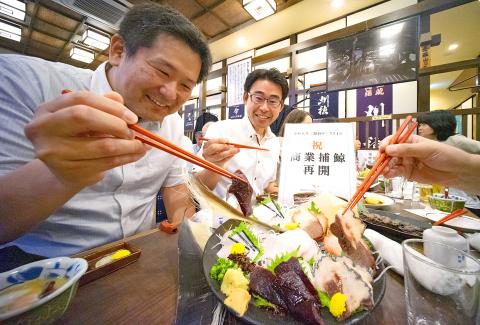“Two sashimis, three steaks,” cries the waitress at one of Tokyo’s most famous whale restaurants during a frantic lunchtime service, where Japan’s resumption of commercial whaling has cooked up new hope.
Mitsuo Tani has spent 46 of his 64 years preparing and cooking whale meat and hosts a mixed clientele at his restaurant: salarymen in white shirts gulping down a quick lunch before heading back to the office, single women, retired couples.
Whale steak is the most popular dish at US$9 — a thin rectangular piece of meat with as much rice, miso soup, vegetables and iced tea as the customer can eat. Also flying out of the kitchen is whale sashimi — raw slices of whale flesh, skin or liver.

Photo: EPA-EFE
Japan’s resumption of commercial whaling has prompted fury from other countries and campaigners, with activists saying that one of the three species targeted is threatened with extinction and sub-populations of the other two are depleted.
But veteran whale chef Tani is keen to promote the health benefits of whale meat.
“It is five times lower in calories than beef, 10 times lower in cholesterol, two times less fat than chicken. It’s packed with iron. But abroad, people do not know this,” he said.
Not all would agree with Tani’s health-based sales pitch, however. In 2015, when the Environmental Investigation Agency tested the mercury levels of whale meat sold in Japan, they found it riddled with the substance.
Whipping up a “whale roast beef” at the pass, Tani explained that he had to move from the northern city of Sendai after the 2011 tsunami and the price of whale meat soared amid a significant drop in supply.
In Tokyo, he has never had any problem procuring meat. While Japan was still part of the International Whaling Commission (IWC), the whales caught in Antarctic waters for “research” purposes still ended up as sashimi and steak on plates around the country.
Ironically, with Japan leaving the IWC and resuming commercial whaling off its own coast, the quantity of meat may decline.
Japan set an annual quota of more than 600 whales while in the IWC.
The cap now stands at 227 until the end of the year — 52 minke, 150 Bryde’s and 25 sei whales.
It is not the only country carrying out hunts, with Norway and Iceland conducting them in recent years and indigenous people from Alaska to Greenland allowed exemptions to the moratorium.
Hitting back at those who fear the resumption of commercial whaling further endangers whales, Japanese authorities say the quotas have been set carefully “to keep the whale population at a sustainable level.”
“I’m scared that the quantity of whale meat will go down,” admitted Tani.
‘WELL COOKED’
Another whale restaurant boss, Sumiko Koizumi, hailed the resumption of whaling as “an excellent thing” and said it was down to chefs to promote the meat and dream up new recipes.
Removing the stigma around whale meat will make it easier for consumers, she said, “first because supermarkets will be more inclined to offer it and wholesalers will listen more to our needs and be in a position to meet them.”
Kenta Yodono, sales manager at the Kyodo whaling firm that operates Japan’s flagship whaling boat, said the commercial hunts would catch different species of whales, which would taste slightly different.
“The commercial species will be different and certain people might be concerned that they will not have the same taste. But in general, I think the quality will improve and we can respond to restaurants’ needs,” Yodono said.
He acknowledged activists’ concerns over the cruelty of the whale hunt and said “the fishermen are conscious of the fact that the time the animal suffers should be reduced.”
However, Tani does have some fears over the immediate future of his industry, with few chefs training to acquire the specialized cooking skills required.
“With commercial whaling halted for more than 30 years, no one has got into the business and that will not happen overnight,” he said.
“Even if some people get into it now, it will take 30 years. And if they find the work too hard, they will stop. Whale needs to be well-cooked otherwise no one will start to eat it again,” added Tani.
Japan has defended the controversial whale hunt as a key part of its tradition and rich culinary heritage. And Tani agreed.
“A country that does not preserve its food culture has no future.”

April 14 to April 20 In March 1947, Sising Katadrepan urged the government to drop the “high mountain people” (高山族) designation for Indigenous Taiwanese and refer to them as “Taiwan people” (台灣族). He considered the term derogatory, arguing that it made them sound like animals. The Taiwan Provincial Government agreed to stop using the term, stating that Indigenous Taiwanese suffered all sorts of discrimination and oppression under the Japanese and were forced to live in the mountains as outsiders to society. Now, under the new regime, they would be seen as equals, thus they should be henceforth

Last week, the the National Immigration Agency (NIA) told the legislature that more than 10,000 naturalized Taiwanese citizens from the People’s Republic of China (PRC) risked having their citizenship revoked if they failed to provide proof that they had renounced their Chinese household registration within the next three months. Renunciation is required under the Act Governing Relations Between the People of the Taiwan Area and the Mainland Area (臺灣地區與大陸地區人民關係條例), as amended in 2004, though it was only a legal requirement after 2000. Prior to that, it had been only an administrative requirement since the Nationality Act (國籍法) was established in

Three big changes have transformed the landscape of Taiwan’s local patronage factions: Increasing Democratic Progressive Party (DPP) involvement, rising new factions and the Chinese Nationalist Party’s (KMT) significantly weakened control. GREEN FACTIONS It is said that “south of the Zhuoshui River (濁水溪), there is no blue-green divide,” meaning that from Yunlin County south there is no difference between KMT and DPP politicians. This is not always true, but there is more than a grain of truth to it. Traditionally, DPP factions are viewed as national entities, with their primary function to secure plum positions in the party and government. This is not unusual

US President Donald Trump’s bid to take back control of the Panama Canal has put his counterpart Jose Raul Mulino in a difficult position and revived fears in the Central American country that US military bases will return. After Trump vowed to reclaim the interoceanic waterway from Chinese influence, US Defense Secretary Pete Hegseth signed an agreement with the Mulino administration last week for the US to deploy troops in areas adjacent to the canal. For more than two decades, after handing over control of the strategically vital waterway to Panama in 1999 and dismantling the bases that protected it, Washington has